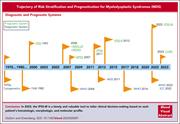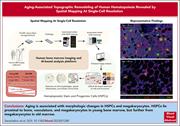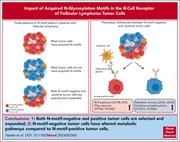Issue Archive
Table of Contents
EDITORIAL
Introduction to a review series on myelodysplastic syndromes in the age of genomic medicine
There has been rapid change in our understanding of clonal hematopoiesis and its relationship to myelodysplasia. In this Review Series edited by Special Section Editor Mario Cazzola, 4 articles by leading experts highlight recent advances in knowledge and put them in current perspective to assist in the diagnosis, prognostication, and treatment of myelodysplastic syndromes.
BLOOD COMMENTARIES
REVIEW SERIES
Causes and consequences of clonal hematopoiesis
There has been rapid change in our understanding of clonal hematopoiesis and its relationship to myelodysplasia. In this Review Series edited by Special Section Editor Mario Cazzola, 4 articles by leading experts highlight recent advances in knowledge and put them in current perspective to assist in the diagnosis, prognostication, and treatment of myelodysplastic syndromes.
Diagnosis and classification of myelodysplastic syndromes
There has been rapid change in our understanding of clonal hematopoiesis and its relationship to myelodysplasia. In this Review Series edited by Special Section Editor Mario Cazzola, 4 articles by leading experts highlight recent advances in knowledge and put them in current perspective to assist in the diagnosis, prognostication, and treatment of myelodysplastic syndromes.
The trajectory of prognostication and risk stratification for patients with myelodysplastic syndromes
There has been rapid change in our understanding of clonal hematopoiesis and its relationship to myelodysplasia. In this Review Series edited by Special Section Editor Mario Cazzola, 4 articles by leading experts highlight recent advances in knowledge and put them in current perspective to assist in the diagnosis, prognostication, and treatment of myelodysplastic syndromes.
Clinical decision-making and treatment of myelodysplastic syndromes
There has been rapid change in our understanding of clonal hematopoiesis and its relationship to myelodysplasia. In this Review Series edited by Special Section Editor Mario Cazzola, 4 articles by leading experts highlight recent advances in knowledge and put them in current perspective to assist in the diagnosis, prognostication, and treatment of myelodysplastic syndromes.
HEMATOPOIESIS AND STEM CELLS
Spatial mapping of human hematopoiesis at single-cell resolution reveals aging-associated topographic remodeling
Assessment of human bone marrow (BM) has always been a visual exercise, and artificial intelligence systems have the potential to improve both diagnostic accuracy and understanding of biology. Sarachakov et al exploited convolutional neural networks and multiparameter tissue staining to address questions about the topography of the BM. The authors report that hematopoietic stem and progenitor cells (HSPCs) lie proximal to bone, vasculature, and megakaryocytes in young BM but farther from megakaryocytes in old marrows, and that aging is associated with morphological changes in HSPCs and megakaryocytes.
LYMPHOID NEOPLASIA
Follicular lymphoma evolves with a surmountable dependency on acquired glycosylation motifs in the B-cell receptor
The biology of follicular lymphoma (FL), with its often waxing and waning clinical course, continues to surprise at the molecular level. By taking sequential biopsies and integrating single-cell RNA and B-cell receptor (BCR) sequencing with analyses of recurrent FL driver genes, Haebe and colleagues demonstrate that some subclones can lose key N-linked glycosylation motifs causing reduced BCR signaling and that this can be more than compensated for by upregulation of metabolic pathways enabling subclonal outgrowth. These findings help explain why FL remains a challenge despite many therapeutic advances.
THROMBOSIS AND HEMOSTASIS
Anti-PF4 immunothrombosis without proximate heparin or adenovirus vector vaccine exposure
Clinical Trials & Observations
Antibodies to platelet factor 4 (PF4) are central to the pathology of heparin-induced thrombocytopenia (HIT) and vaccine-induced thrombocytopenia and thrombosis. Schönborn and colleagues identified the occurrence of prothrombotic platelet activating anti-PF4 antibodies in patients with thrombosis and thrombocytopenia but in the absence of heparin or vaccination exposure. Importantly, for the care of patients with this novel disorder, these antibodies are not heparin-dependent, distinguishing it from spontaneous HIT.
TRANSFUSION MEDICINE
Optimizing platelet transfusion through a personalized deep learning risk assessment system for demand management
The short shelf life of platelets and variable clinical demand mean that wastage is often high. Engelke et al sought to better predict demand for platelet transfusions in cardiothoracic surgery and hemato-oncology by applying a deep learning approach, the long short-term memory model. The authors’ data reveal the potential for this method to identify high-risk patients and improve inventory management, but further optimization is required, especially outside the hemato-oncology setting.
LETTER TO BLOOD
Tafasitamab and lenalidomide in large B-cell lymphoma: real-world outcomes in a multicenter retrospective study
Clinical Trials & Observations
Clinical trials guide decision making in routine practice, but there is not always alignment between trial populations and the patients with high unmet clinical needs in the community, and this creates challenges. Qualls and colleagues demonstrate stark discrepancies in outcomes for patients with relapsed or refractory diffuse large B-cell lymphoma treated with tafasitamab plus lenalidomide between the registration trial and a real-world series of 189 patients, where 89% would not have been eligible for the trial. Outcomes in the real-world series were very poor (31% response rate and a median progression-free survival of 1.9 months), suggesting that, for this regimen, patients in practice should be selected to match those in the trial.
BLOOD WORK
-
Cover Image
Cover Image
![issue cover]()
Multiplex immunofluorescence image of normal bone marrow core biopsy tissue from an adolescent, part of an artificial intelligence–based spatial analysis of hematopoiesis across ages. Conspicuous hematopoietic populations include CD71+ erythroid normoblast islands (red), collections of CD15+ myeloid elements (cyan), and singly scattered, normal, mature CD61+ megakaryocytes (yellow). See the article by Sarachakov et al on page 2282.
- PDF Icon Front MatterFront Matter
- PDF Icon Table of ContentsTable of Contents
- PDF Icon Editorial BoardEditorial Board
Advertisement intended for health care professionals
Email alerts
Advertisement intended for health care professionals











Toward an anatomy of human hematopoiesis